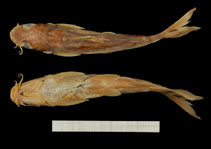| Family: |
Claroteidae (Claroteid catfishes), subfamily: Claroteinae |
| Max. size: |
23.1 cm SL (male/unsexed) |
| Environment: |
demersal; freshwater |
| Distribution: |
Africa: endemic to the Nyong River in Cameroon (Ref. 81642). |
| Diagnosis: |
Dorsal spines (total): 2-2; Dorsal soft rays (total): 6. Diagnosis: width (as percentage of length) of occipital process) 67-93% (average 79%); depth (as percentage of width) of premaxillary tooth plate 29-43% (average 35%); vomerine dentition generally present as isolated teeth, exceptionally forming small tooth plates, palatine teeth mostly absent, but sometimes present (in mature males)(Ref. 81642).
Description: snout pointed; mouth rather small, with a premaxillary toothband width 12.5-20% (generally 16.6%) HL; occipital process broad (base length 6-8 times in HL); vomerine dentition present as small toothbands (in 47% of specimens), as a few isolated teeth (in 35% of specimens) or absent (in 18% of specimens); few individuals have 1-2 palatine teeth, but great majority lack a palatine dentition; dorsal fin of medium height (29-37% SL); anal fin with 4-5 soft unbranched rays and 7-9 branched rays; (only three) males (160-186 mm SL) with enlarged testes and a single gravid female (172 mm SL) are known; mature males do not exhibit inflated heads and widened mouths of Chrysichthys and Melanodactylus species, however their vomerine dentition is more pronounced and present as a small tooth plate, and all have teeth on palatine (Ref. 81642).
Coloration: preserved specimens with head and dorsum dark brown, creamy white ventrally (Ref. 81642). |
| Biology: |
|
| IUCN Red List Status: |
Vulnerable (VU); Date assessed: 16 February 2009 (D2) Ref. (130435)
|
| Threat to humans: |
harmless |
Source and more info: www.fishbase.org. For personal, classroom, and other internal use only. Not for publication.

